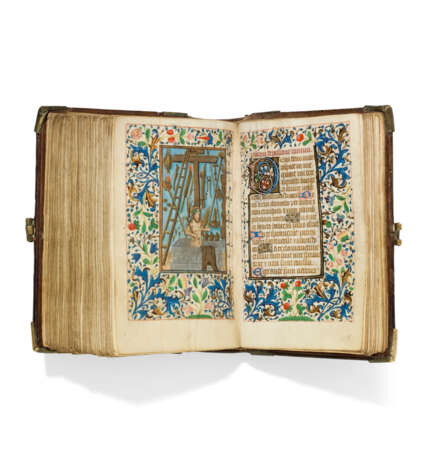ID 381222
Lot 15 | Workshop of Willem Vrelant (act. Bruges c.1454 onwards)
Estimate value
£ 40 000 – 60 000
A Bruges export Book of Hours whose first English owner may be identifiable as Thomas Skevington, bishop of Bangor (d.1533), featuring a notably inventive and full programme of illumination associable with the workshop of Willem Vrelant.
109 x 76mm. 243 + iv, bound too tightly to collate but apparently complete, modern foliation in pencil added sporadically, 17 lines, ruled space: 60 x 37mm, rubrics in red, illuminated initials throughout, 22 historiated initials accompanied by borders in three margins, 29 large miniatures on inserted leaves facing five-line illuminated initials all within full borders (the Flagellation opening a little water-stained, the Last Judgement opening a little stained, two more of the miniature leaves cockled). Contemporary English blind-stamped calf over wooden boards, the original Adam and Eve panel stamp overlaid by the gilt armorial crest of a bird belonging to a later owner, brass corner-pieces and remains of clasp, labelled on spine (modern restoration to centre of upper cover and extremities of spine). Modern case.
Provenance:
(1) Written and illuminated in Flanders for the English market, with Sarum liturgy, and an English selection and sequence of texts (including memorials after Lauds and the Commendation of Souls). Saints venerated in England appear in the calendar – Wulstan (19 January), Edward the Martyr (18 March), Cuthbert (20 March), Thomas Becket (7 July) and Edward the Confessor (13 October) – and Thomas Becket appears in the suffrages, alongside St George, and again amongst the memorials.
(2) ?Thomas Skevington, bishop of Bangor (d.1533): an ownership inscription in a contemporary English hand added at the beginning of the Hours of the Virgin (f.58) reads ‘T. Skeffyngton’. The English Cistercian monk Thomas Skevington, son of a prominent Leicestershire family, became abbot of Waverley Abbey in Surrey in 1477 and of Beaulieu Abbey in Hampshire in 1508, before being appointed bishop of Bangor in 1509. His tentative identification as the original owner of these Hours – whose production would have roughly coincided with the start of his tenure at Waverley – might be supported by the text, which is highly abbreviated, suggesting a strong familiarity with the liturgy.
(3) The Thomas Becket suffrage miniature and its accompanying text are undefaced, suggesting that the manuscript remained in Catholic hands during the Reformation, when the erasure of such devotions to the saint was decreed by Henry VIII.
(4) Christie’s, 16 July 1969, lot 146; bought by:
(5) Bernard Quaritch, booksellers; from whom acquired on 23 July 1972 by:
(6) Helmut N. Friedlaender (1913-2008; his bookplate inside the first board). The present manuscript was the first acquisition of the American bibliophile Helmut N. Friedlaender, whose collection of important incunabula, medieval manuscripts and other rare books was sold at Christie’s, 23-24 April 2001; such was its personal significance to Mr Friedlaender as the spark of his great passion for beautiful books, he did not offer it for sale in 2001.
Content: Calendar ff.1-12; Prayer to Christ ff.14-23; Suffrages to: the Trinity ff.24-25; John the Baptist f.27-28; St John f.29; St George f.31; St Christopher ff.33-34; Thomas Becket ff.35-36; St James the Greater f.38; St Sebastian ff.40-41; St Elmo ff.43-44; St Antony Abbot f.46; St Anne f.48; Mary Magdalene ff.50-51; St Catherine ff.52-53; St Barbara f.54; St Margaret f.56; Hours of the Virgin, use of Sarum, with memorials after Lauds ff.58-114; Seven Joys of our Lord ff.115-116; Devotions to the Virgin Mary, including the Five Joys of the Virgin, the hymn Ave virgo virginum stella matutina and the O intemerata ff.116v-133; further prayers, including prayers to the wounds of Christ ff.133v-145; Seven Penitential Psalms followed by the Litany ff.147-167; Office of the Dead ff.169-199; Commendation of Souls ff.201-217; Psalms of the Passion ff.219-225; Psalter of St Jerome preceded by the rubric and prayer ff.226-243.
Illumination: The style of the miniatures suggests they were painted in Bruges, the centre of the export trade to England in 15th-century Flanders; these Hours appear to have emanated from the workshop of Willem Vrelant – who had settled in Bruges by 1454 and rapidly attained commercial success as well, as the patronage of the Dukes of Burgundy – or one of his followers. Vrelant and his workshop specialised in small Books of Hours such as this one; his widely-emulated style can be best identified here in the strong palette, setting blue against yellow, orange and red, and emphatic black lines to detail and outline. The artist responsible for these miniatures displays a certain inventiveness in carrying out a notably full programme of illumination: the representation of the Trinity, with Christ as Man of Sorrows supported before God the Father by the Holy Spirit in the form of an angel is less usual.
The subject of the large miniature are as follows: Christ Blessing f.13v; the Trinity f.23v; John the Baptist f.26v; St John f.28v; St George f.30v; St Christopher f.32v; Thomas Becket f.34v; St James the Greater f.37v; St Sebastian f.39v; St Elmo f.42v; St Antony Abbot f.45v; St Anne f.47v; Mary Magdalene f.49v; St Catherine f.51v; St Barbara f.53v; St Margaret f.55v; Agony in the Garden f.57v; Arrest of Christ f.67v; Christ before Pilate f.86v; Flagellation f.92v; Christ carrying the Cross f.96v; Crucifixion f.100v; Deposition f.104v; Entombment f.108v; Last Judgement f.146v; Raising of Lazarus f.168v; Souls borne to Heaven f.200v; Christ as Man of Sorrows surrounded by the instruments of the Passion f.218v; St Jerome f.228v.
The historiated initials are on ff. 77, 78v, 79, 80, 80v, 81, 82, 84, 117v, 123, 129, 133v, 134, 134v, 135, 135v, 136, 136v, 137, 137v, 138, 139v.
| Address of auction |
CHRISTIE'S 8 King Street, St. James's SW1Y 6QT London United Kingdom | |
|---|---|---|
| Preview |
| |
| Phone | +44 (0)20 7839 9060 | |
| Buyer Premium | see on Website | |
| Conditions of purchase | Conditions of purchase |








